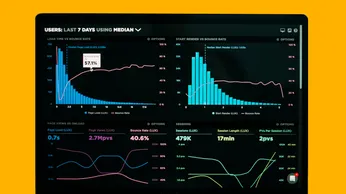On this page
Revenue is not random. It reflects how well your business understands its customers, aligns its teams, and sharpens its execution. That’s what revenue performance is all about. It captures how effectively your company turns effort into income, using revenue as the central signal of progress and potential.
To move from guesswork to control, businesses need more than intent. They need a clear system to track, manage, and improve revenue-related outcomes. That’s the role of revenue performance management.
It helps businesses identify what’s working, fix what’s not, and create repeatable structures that turn top-line goals into reality.
This guide unpacks everything you need to know about revenue performance. Here, you’ll learn:
- What is revenue performance?
- What is revenue performance management?
- Why are they important for a business?
- How to measure and improve revenue performance?
- How to implement a revenue performance system in your organization?
- How to boost revenue and improve financial performance with revenue performance management software?
What is revenue performance?
Revenue performance is a core success indicator in business. It reflects the effectiveness of a company’s growth and improvement-related endeavours using revenue as the key barometer and central KPI.
Stripped to its essence, revenue performance is about how much ‘top line money’ a business is earning from its markets. All other things being equal, the more revenue a company generates, the stronger it is.
While revenue performance isn’t the same as profitability (since revenue performance focuses on top-line growth while profit measures net income), it is still a key metric to consider when evaluating the financial health or fiscal viability of a commercial entity such as a business.
Revenue performance: definition
Revenue performance is a data-driven methodology that offers a 360-degree snapshot of the health and status of the various activities and functions that have a direct or prominent bearing on an organization’s revenue generation outcomes.
Revenue performance evaluates and reviews how well these functions are performing, and endeavors to offer suggestions and solutions to help the business improve in these areas.
Some of these areas are sales, marketing, product development, go-to-market (GTM), customer support, and customer success. Among these, sales and marketing – along with the collaborative interplay between the two – are the most important in the specific context and scope of revenue performance, since the term "revenue," according to many definitions, refers strictly to proceeds from sales.
The concept of revenue itself represents the ultimate culmination or fruition of most departments and endeavors present in a typical organization. Revenue performance, too, is a derived calculation.
The roots of revenue performance lie in multiple revenue-centric estimates and metrics, such as customer lifetime value, customer acquisition cost, and customer churn rate, among others.
At heart, a revenue performance system is all about:
- Understanding what drives revenue for an organization.
- Monitoring and measuring it closely and regularly.
- Optimizing capacity and resources to generate it with increasingly higher levels of proficiency, predictably and consistently.
The above involves
- Predictive planning.
- Being customer first.
- Alignment of teams.
- Leveraging data analytics.
- Maximizing revenue-earning potential (chops).
Why is revenue performance important in business?
Revenue performance is important simply because revenue is important.
Revenue is the lifeblood of a business. From market demand to the effectiveness of sales and marketing functions to the ability to attract talent to the readiness of expansion into new markets to investor confidence and access to capital to stability and sustainable growth, revenue is an authentic, effective and holistic indicator of a company’s status in practically every area that is important to its survival and success.
Importance of revenue performance.
- Revenue performance measures how efficiently the business generates revenue.
- Revenue performance helps teams meet business goals and stay on track with their financial targets.
- Investors wield revenue performance as an instrument of assessment to evaluate a company’s worth.
- Revenue performance systems aim to optimize operations and resources, to enhance revenue-generating capabilities.
- Revenue performance helps diagnose opportunities for improvement in sales and marketing.
- Revenue performance analytics supports future planning and sustainable growth.
How to measure and revenue performance?
Ticking revenue metrics with revenue performance management.
Every business generates revenue. The real question is, can yours generate it at will, and on demand? In other words, predictably, quarter after quarter, year on year? When it comes to business performance, that’s what separates the pros from the boys.
There’s nothing business leaders crave more than control over their revenue-generating engines – the kind that will let them rake in moolah consistently and sustainably. Revenue performance management helps them master the art and science of doing that.
What is revenue performance management?
In his bestseller $100 Million Offers, business mind Alex Hormozi insinuates that there are only three ways to grow a business: Acquire more customers, increase the value of each customer, or make each customer buy more (and more).
Revenue performance management is all about figuring out how to apply Hormozi’s premise in practice.
Revenue performance management can be defined as the methodology of optimizing revenue performance frameworks and outcomes in a business.
Typically carried out by RevOps team, the discipline of revenue performance management involves understanding the systems, processes, and behaviors that tie back to revenue, directly or indirectly, in a small or significant way, and continuously enhancing them with sharp customer, marketing, and sales approaches to create revenue-boosting change.
This entails working cross-functionally across strategy, lead generation, and customer success teams to weed out inefficiencies and build on strengths.
A simplified approach to revenue performance management can look like this:
- Step 1: Identify the key metrics and KPIs that drive revenue in your business, with a particular focus on sales and marketing activities.
- Step 2: Understand the interplay of forces and factors that influence those metrics.
- Step 3: Build a revenue performance system that can track, measure, and improve them iteratively.
Let’s dive into each of the three steps, shall we?
Step 1: KPIs that drive revenue
Get your revenue performance management program off on the right foot by shortlisting the revenue KPIs that make the most sense in the specific context of your customers, industry, and offerings.
How to measure revenue performance: Metrics that matter
KPIs and metrics that capture and calibrate revenue performance will vary from business to business. Here are some of the most essential metrics used across various industries and business categories to measure revenue performance.
- Total revenue generated per customer and by the business as a whole
- Annual Recurring Revenue (ARR)
- Revenue growth rate
- Revenue retention - percentage of recurring revenue from existing customers (loyalty)
- Customer Lifetime Value (CLV)
- Customer Acquisition Cost (CAC)
- Customer Satisfaction (CSAT) and Net Promoter Score (NPS)
- Gross and net profit margin
- Market share
- Lead to conversion ratio
- Conversion rate
- Close-Won rate
- Efficiency ratios: asset and resource utilization
- Average contract value
- Sales pipeline velocity
- Sales cycle length
- Revenue per sales rep
- Sales per territory or region
- Upgrades, upsells, and cross-sells
- Renewal rate – key in SaaS
- Customer churn rate (CCR)
Step 2: Factors that drive revenue KPIs
External factors lie outside a company’s control but have a direct or indirect impact on its ability to drive revenue. These influences often shape customer expectations, buying capacity, and market demand.
- Market conditions: Economic winds like boom or inflation, customer behaviour, competition, social movements, and global events can all have a revenue bearing.
- Seasonality: Spikes, plateaus, and calendar occasions may trigger fluctuation in demand and revenue at specific times of the year.
- Industry trends: Disruptions in tech, ideas ,and best practices can generate variance in category dynamic and consumer behavior, impacting revenue.
- Regulatory changes: Tweaks in government regulations can create both opportunities and challenges for businesses, potentially impacting revenue.
Internal factors are within a company’s control and form the core levers it can pull to influence revenue. These reflect the company’s strategic choices, operational strengths, and customer-facing efforts.
- Product and service superiority: The quality of a company’s offerings compared to its competitors is a key determinant of market demand and revenue potential.
- Product attributes: Price, design, feature innovation and brand reputation all contribute to perception, and influence sales and revenue.
- Customer experience: 63% of customers would move on to a rival brand after just a couple of negative experiences with customer support. From addictive in-store experiences to delightful in-app interactions (Apple excels at both), a positive customer experience directly correlates with revenue performance KPIs, including loyalty, referrals, and revenue retention.
Step 3: Controlling revenue KPIs with revenue analytics
How to build a tech-driven revenue performance system that tracks, measures, and amplifies factors influencing revenue metrics - predictably and sustainably.
Revenue analytics lies at the intersection of technology, market intelligence, and best practices. As a function, revenue analytics employs cutting-edge tracking, analysis, and prediction frameworks to help leaders.
- Uncover profitable insights,
- Understand improvement pathways,
- Take efficient decisions around product, operations, and customer.
Revenue analytics rationalizes sales and marketing decisions (clarifying both the why and the how) and enables the foundation for robust revenue performance.
For sales and marketing teams, revenue analytics reduces reliance on subjectivity and guesswork by providing actionable insights and establishing guardrails grounded in fact. When viewed through the lens of experience, it can become a powerful ally in highly intuitive decision-making and a unique competitive edge for the business.
There are broadly three primary steps or chapters to revenue analytics :
Revenue analytics part I: Data gathering
Data lies at the heart of revenue analytics. According to a McKinsey study, organizations led by data are 23X more likely to outperform competitors in customer acquisition, 9X more likely to retain customers, and up to 19X more profitable.
The mandate for revenue leaders is to comb customer touchpoints, marketing funnels and various sales interventions and platforms to curate relevant data.
To ensure richness and inclusivity, leaders must also ensure that data has been culled across an entire spectrum of sources such as customer interfaces, CRM tools and product assets and applications.
Teams must cut short unproductive effort by focussing only the data they need; Revenue performance KPIs discussed earlier can be their guide here.
Here’s a look at some effective niches for sourcing data that can add purpose and value to revenue performance management:
- Market pulse data, such as from surveys, feedback forms, interviews, focus groups, brand perception studies, customer satisfaction scores like NPS, and others.
- Data from website indicators like organic and paid traffic, engagement, page views, time on page, bounce rate, interaction with customer service and chatbots, and others.
- Transactional data such as from invoices, vouchers, coupons and others.
- Data from e-commerce environments such as customer identity, search behaviour, buying patterns, purchase frequency, cart abandonment, and others.
- Data from information aggregators and gatekeepers, online marketplaces, trade communities and groups, mobile, IoT (Internet of Things) devices, apps, and third-party sources.
- Data from loyalty programs, referral campaigns, and others.
- Data from in-store and POS (point of sales) environments.
- Data from social media such as conversations, trends, and sentiments picked up by listening tools.
- Data from marketing and PR campaigns, ads, outreach, activation,s and similar activities.
- Data from calls, emails, demos, customer support interactions, and other channels that mostly live on CRMs and marketing automation software.
- Data from market research, sectoral reports, industry forums, libraries, museums, government records, and various resources available in the open domain.
Revenue analytics part II: Data Analysis
The primary purpose of collecting data is to unlock the stories it holds. Leaders decode these stories for learnings to inform their revenue performance strategies with better forecasting, to empower teams with the right intent and targets, to build customer-first experiences, and to take expert pricing and sales decisions.
The above involves advanced data parsing and analysis, and is designed to help businesses achieve breakthroughs in terms of:
- Refining understanding of customer needs via granular persona segmentation – labels like high spenders, natural advocates, low engagement, and so on.
- Driving mechanisms and team behaviours that can best serve each customer persona.
- Detecting anomalies in the process and disconnects in the system to fix them fast.
- Figuring out activities and spaces that are delivering high ROI so that teams can double down on them.
- Dynamic decision making, which allows for agile adjustments in real time to build change readiness.
Executed right, revenue analytics can prompt refreshing new perspectives. It can also answer old questions like:
- What are the top-performing revenue sources of the business?
- Which customers and territories hold positive potential?
- Is there a need to adjust the pricing strategy?
- Will introducing new features or expanding into new markets make sense at this time?
- How to make revenue engines future-ready?
Artificial intelligence can transform your revenue analytics game. AI tools leverage machine learning algorithms and natural language processing (NLP) to add speed and accuracy to pattern correlation and anomaly recognition.
They can also engineer predictive models and compare contingencies by applying historical data to future scenarios.
Revenue analytics part III: Data management
We list out the critical considerations below.
Revenue supremacy begins with data integrity. Prioritizing and preserving the integrity of your organizational data is key to ensuring that your revenue performance analytics generates high quality insights on a consistent scale.
The concept of data integrity traces to the quality, accuracy and completeness of data sets. Data integrity involves making sure your sales and marketing data is accurate and error free, complete without missing important details, consistent and uniform across contexts without discrepancies, cogent carrying logical coherence, and secure to guard against unauthorized access, modification or deletion.
- Tap into Artificial Intelligence to automate key rituals like data cleaning, data transformation, and data integration to save time while maintaining accuracy.
- Articulate and present the insights extracted from your data in simple and compelling ways with data visualization tools like charts, graphs, and interactive dashboards.
- Prepare real-time reports that communicate key findings with decision makers, prioritizing the big takeaways.
- Centralize data in one single location to democratize a 360-degree view and access for everyone.
Important considerations for improving the revenue performance system
Paying attention to these (caveats and) considerations can accelerate the realization of your revenue performance management goals.
1. Securing executive buy-in
First things first. Favorable nods from the top are an essential requirement for revenue performance management initiatives, as the domain spans multiple teams and departments.
A genuine commitment from leadership that goes beyond mere compliance posturing is a powerful hack in business. It can accelerate your revenue performance management by boosting credibility, reducing resistance to adoption, and increasing engagement.
2. Mastering customer lifecycle management
The customer sits at the centre of a business and, by extension, of any strategy or discussion around revenue and performance.
The customer lifecycle enables leaders to trace and decode their customers' behavior and journey more effectively. The customer lifecycle is a visual structure that maps the various stages and touchpoints prospects pass through as they gradually evolve from curious visitors to engaged customers and ultimately become loyal brand advocates.
Sometimes, the customer lifecycle may also capture the journey of prospects who did not convert, helping to explain why. Leaders who are well-versed in customer lifecycle management are more effective in critical success areas, such as predictive planning, GTM, and customer experience, which lifts sales, customer lifetime value, and ROI.
3. Working the sales funnel
A sales funnel guides potential customers through the buying process in a structured and systematic way. The customer lifecycle, on the other hand, is a broader concept—it covers all experiences, intentional or accidental, successful or not, that a potential customer has with a brand.
A sales funnel is more focused and intent-driven, where the business actively shapes the prospect’s behavior along a defined conversion path.
Finding the natural and seamless ‘fit’ between the customer lifecycle and sales funnel can allow a business to dramatically improve revenue performance by amplifying the processes of customer targeting, lead generation, and customer lifetime value.
4. Aligning teams on a shared reality and common mission.
Departments operating in silos are common in business, and a significant cause of missed opportunities; here’s why silos suck. Information bottled up in cubicles and folders hinders cross-pollination of ideas, causing innovation, productivity, and ultimately outcomes to suffer.
Without a common ground that makes sales, marketing, and customer success march in lockstep, revenue performance metrics become impractical and fall flat. Bridge the gap and unlock team synergies by creating a unifying language and framework that’s based on
- Common visions and priorities
- A unified understanding of the customer
- GTM motions were voted on by everyone
- Collaboration-first frameworks
- Frictionless handoffs
- Consistent messaging
This will help optimize operations, flywheel efficiency, reduce costs, and unlock more opportunities.
5. Piggybacking on revops
Amplifying revenue performance is far easier if your organization already has a revenue-first mindset and environment. In other words, a RevOps (Revenue Operations) framework is going.
RevOps VS revenue performance: Understanding contrasts and commonalities
While both aim to maximize revenue outcomes, they do so from different angles. One focuses on aligning teams and processes, while the other leans on data to refine specific functions. Let’s break down how they compare and where they intersect.
1. Scope of focus: organization-wide vs sales & marketing
RevOps is a broad, organization-wide initiative that structures and aligns each revenue-generating engine, including sales, marketing, customer support, operations, and customer success teams.
Revenue performance, on the other hand, has a narrower scope. Revenue performance is a data-driven methodology that aims to optimize sales and marketing by examining them through the lens of revenue.
2. Coverage: Entire revenue lifecycle vs select stages
RevOps encompasses the entire revenue lifecycle of the business, spanning from lead generation to conversion, loyalty, and expansion.
Revenue performance limits itself to sales and marketing.
3. Approach: Operational execution vs analytical strategy
RevOps is operations and application-driven.
Revenue performance is analysis- and prescription-driven.
The two, of course, have revenue as the common, overarching context.
Both RevOps and revenue performance aim to turn revenue generation into a predictable business edge through continuous review, reinforcement, and refinement.
At an operational level, commonalities between the two constitute an emphasis on dissolving boundaries, building collaborative interoperability between revenue-first functions, and the strategic adoption of data analytics and technology platforms for greater efficiency, automation, and impact.
Figuring out the right tech
With its pronounced dependency on revenue analytics, the right technology stack can spell the difference between success and failure when it comes to an organization’s revenue performance project.
Partnering with the right revenue performance management software can turbocharge both revenue performance and financial performance.
How to choose a revenue performance software that’s right for your product, industry, and business context?
Factors to keep in mind when trawling supermarket shelves for a revenue performance management software that hits every spot are:
1. The revenue performance software can frictionlessly correlate your grand organizational purpose and your big business goals. It should be able to translate the first and quantify the second, on the same page.
2. The revenue performance software should integrate seamlessly with the stacks and systems (CRM, CMS, etc) you currently use.
3. Your revenue performance software should be able to crunch complicated data sets and perform sophisticated, multi-dimensional calculations.
4. It should be simple to operate – not everyone on your team will carry expert-level tech savvy.
5. Any revenue performance software worth its salt will generate robust, real-time reports. It must, in addition, provide data visualization and dashboard features.
6. Make sure your revenue performance software delivers on key data parameters like data integrity.
7. Make sure the revenue performance software you are mulling for a possible purchase comes with top notch security and data confidentiality features.
8. Your revenue performance software must carry in-built compliance with regulatory guidelines and legal protocols.
9. Last but certainly not least, your revenue performance software should carry AI and Machine Learning capabilities. This one’s fast becoming table stakes.
Revenue performance and its management, like most business transformation initiatives, is more about mindset than about compliance and rituals.
Communicate your big vision candidly with teams (explaining the Why as much as the How) to earn their trust, build a favorable climate that encourages change without rushing it, ensure feedback is relentlessly processed for actionable lessons, and recognize and reward early adopters to set the right example.
Drive your revenue performance initiatives effortlessly with Compass
Did you know businesses improve their sales productivity by as much as 80% when they switch to Compass, Xoxoday’s revenue management tool?
Change is easier with Compass.
Compass is a secure and scalable enterprise-grade platform that’s trusted by giants like Coca-Cola, Mercedes-Benz, and AT&T (amongst others) to elevate sales productivity, compensation management, and team motivation to the next level.
Inspire significant new behaviors in sales teams and channels, and tick new targets in your quest towards revolutionizing profit and revenue generation, with success-first mechanisms like gamification, helpful insights, timely nudges, in-moment coaching, supportive communities, and over 10Mn hyper hyper-personalized incentives and rewards choices redeemable across 100+ countries and countless categories.
Compass is AI-powered, plug-and-play, and integrates seamlessly with nearly every technology and system available. This means you get to experience real results in just days, not weeks.
To understand how Compass plugs into your company’s future revenue ambitions, book a demo TODAY.















